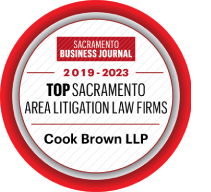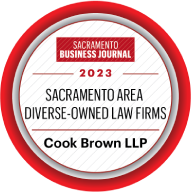California is a battleground for wage and hour litigation. There are a number of reasons why. One is the difficulty that even the best-intentioned employers have managing and enforcing meal and rest breaks for hourly employees. What does the law say? Cook Brown Partner Terry Wills looks at California meal and rest break law and offers steps that employers can take to enhance compliance.
Transcript
Hello, I’m Terry Wills, a partner at Cook Brown. Welcome to our labor and employment law podcast.
Cook Brown is a California law firm representing public and private sector employers in labor and employment matters involving everything from routine advice to complex class action litigation.
As you may know, California is a battleground for wage and hour litigation in state and federal courts. Today I am going to be talking about one specific area of wage and hour litigation – meal and rest breaks.
Before we get started, I have to remind you that this podcast is for informational purposes only. It doesn’t create an attorney-client relationship between Cook Brown and the listener and shouldn’t be treated as legal advice. It is important that you consult a local attorney for specific advice applicable to your company and tailored to your needs.
Class action and individual wage and hour litigation outpaces nearly every other category of employment claim filed in California today. What we see when we defend these lawsuits is that one of the most difficult areas of wage and hour law for companies to manage are meal and rest breaks for hourly employees. In this podcast we’ll be referring to them as non-exempt employees.
So let’s take a look at what the meal and rest break laws are in California.
Meal Breaks
Employees must be authorized and permitted to take a minimum 30-minute meal break by no later than the end of the employee’s fifth hour of work. That means that if an employee starts work at 8:00 a.m. she must take her meal break no later than 12:59 p.m.
If the employee’s total shift is no more than six hours, the meal break can be waived by mutual agreement of the employee and the employer. And here, I want to emphasize the words “mutual agreement.”
That 30-minute meal period must be uninterrupted. It’s very important to understand that. Employees who eat at their desk or other work area can’t be asked to take on a task at the same time. No phone answering, no casual conversation about what work needs to be done when the break is over, etc. It must be completely uninterrupted.
After that, non-exempt employees must take a second 30-minute meal break by no later than the end of the 10th hour of work. That second meal period can also be waived. But there some conditions:
- First, there has to be mutual agreement between the employee and the employer and this one has to be in writing.
- Second, they had to have taken the first meal break during the first 6 hours.
- Third, the total shift worked can’t exceed 12 hours in order for the meal break to be waived.
Most employees are interested in waiving their second meal break. Typically, they’d rather finish their shift and get home rather than take that second lunch and work longer. So it’s important for you to get a valid meal period waiver signed by employees in order to take advantage of the process.
And remember, employees are required to record their meal breaks on their timesheets or through electronic timekeeping processes. They need to show the time that they clocked out for lunch and then the time that they clocked back in. They cannot simply state that it was for 30 minutes or an hour that they clocked out for lunch.
Ten-Minute Rest Breaks
Nonexempt employees who work at least 3.5 hours in a day must be authorized and permitted to take one 10-minute rest period for every four hours worked, or a major fraction thereof. That can be confusing. What you need to remember is that California courts consider anything over 2 hours to be a major fraction of four hours.
Rest breaks don’t have to be recorded. But employers should keep track of them so that it’s clear that employees are being provided with breaks under the law.
During both meal and rest breaks, employees must be relieved of all duties. And employers have no control over how employees spend their break time.
It also isn’t permissible to have employees be “on call” during meal or rest breaks. The California Supreme Court decision drove home that last point in a recent class action lawsuit. Security guards filed suit against their employer ABM security because they were being required to keep radios and pagers on during rest breaks. The Court found this constituted “employer control” because it didn’t release employees of all duties.
If an employee doesn’t receive a timely and fully uninterrupted meal and/or rest break, California law requires they be paid a premium of one hour of pay at their regular rate. So a missed rest break and a late lunch in the same shift could result in 2 hours of premium pay for the employee.
Keep The Workplace Working
Most managers sincerely believe they’re properly providing meal and rest breaks and a lot of them seem to be caught off guard by employee lawsuits. So what can an employer do to make sure they’re following these stringent rules and requirements under California law?
The first step is to be sure your organization has a valid and effective written meal and rest period policy. The policy should address things like when meal/rest breaks are to be taken and what to do when a break isn’t taken. The written policy can make all the difference in defending a class action meal/rest period case.
The second step to provide training for everyone who supervises employees so that they understand and know how to enforce meal and rest breaks.
Finally, there has to be a thorough review of time records to make sure employees are taking and recording meal breaks before the end of the fifth hour. This is critical.
One more safeguard though. We recommend that HR or payroll managers make spot checks to confirm that employees clearly understand the company’s meal and rest break policy and the company’s requirement that employees follow it.
Those check-ins with the employees will equip the company with information to determine whether meal and rest break policies are being followed.

